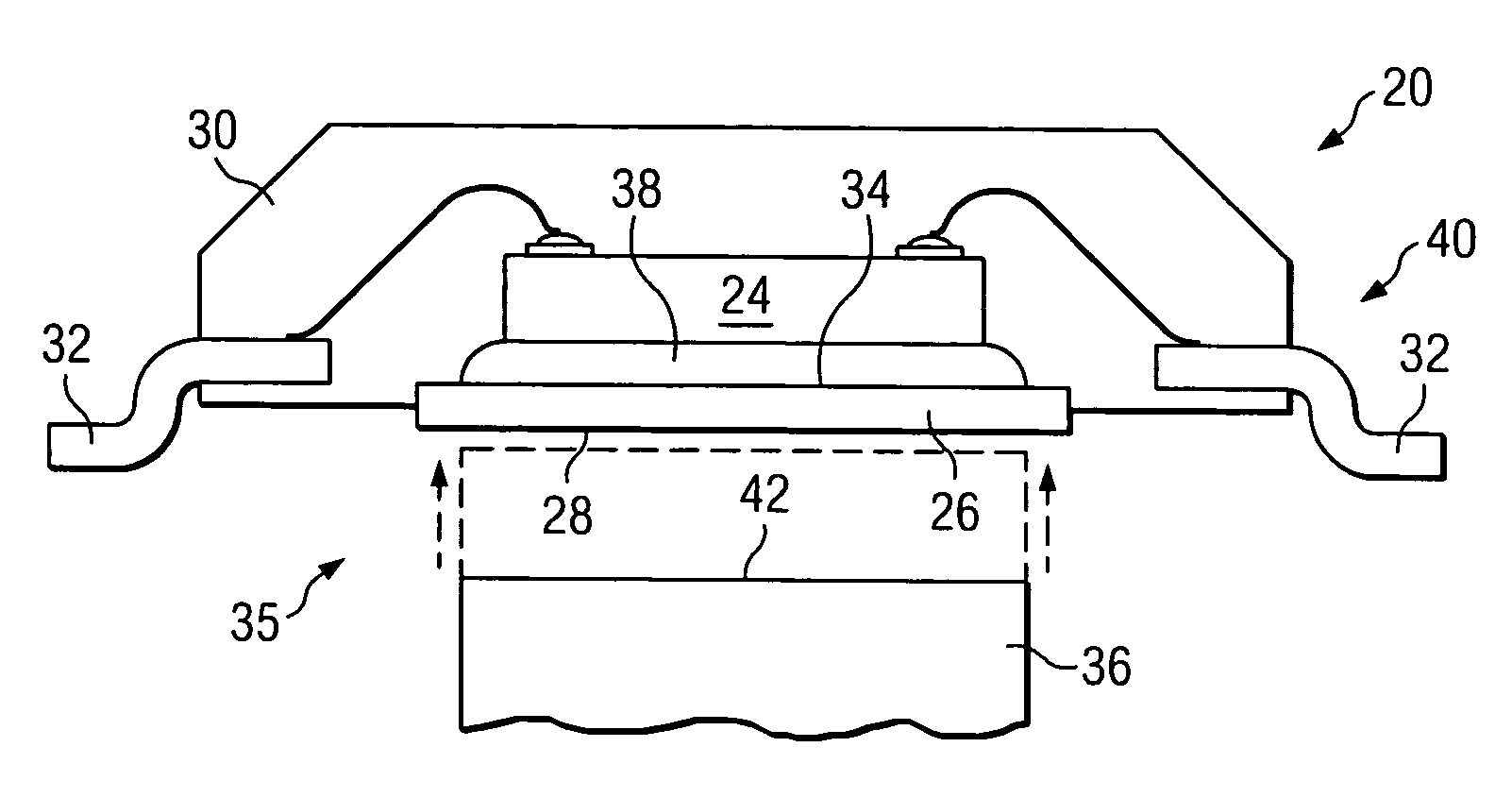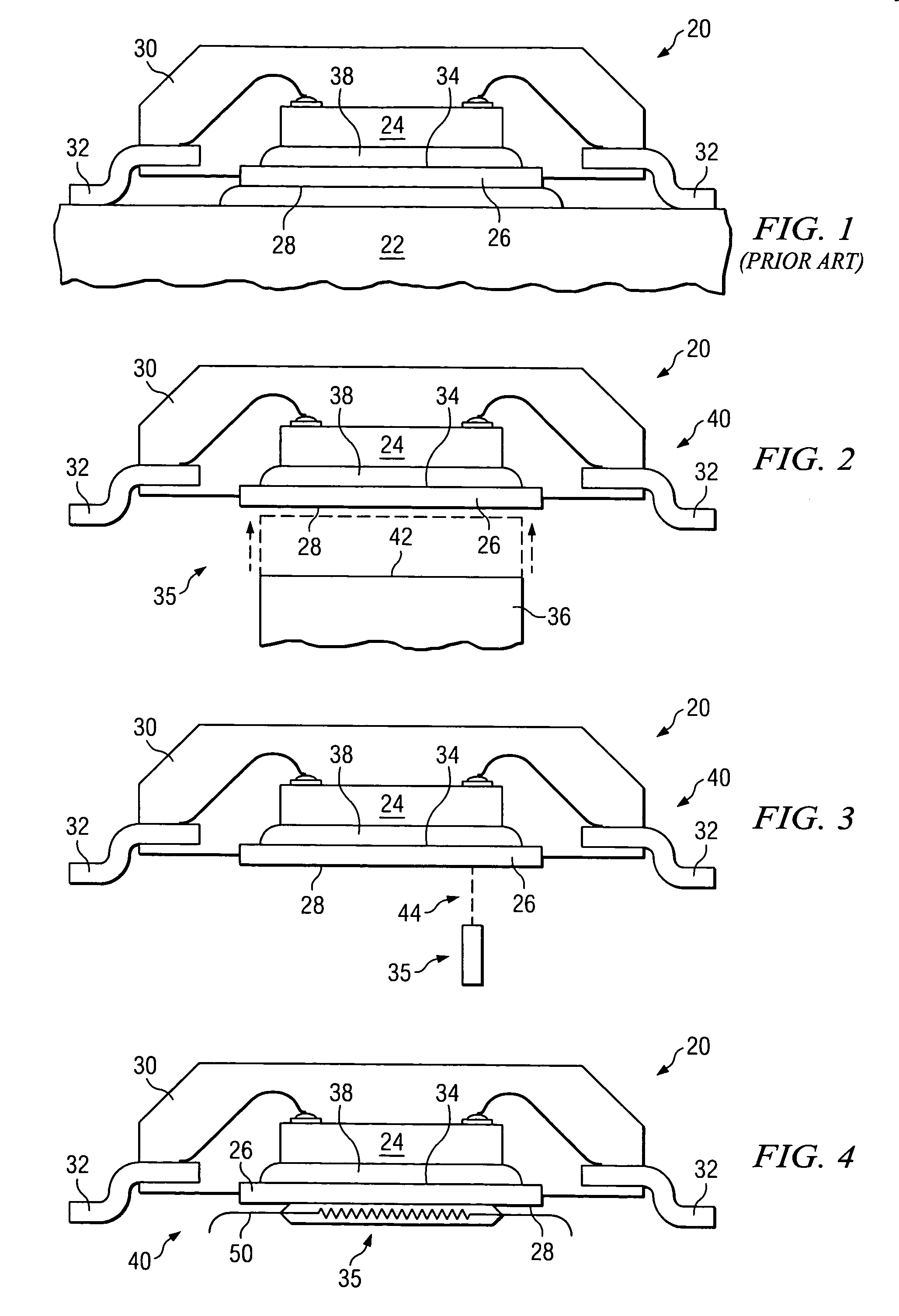Thermal testing method for integrated circuit chips and packages
a technology of integrated circuit chips and packages, which is applied in the direction of semiconductor/solid-state device testing/measurement, semiconductor/solid-state device details, instruments, etc., can solve the problems of affecting the reliability and/or performance of the integrated circuit (ic) chip during operation, causing more heat, and reducing the reliability of the integrated circuit (ic) chip
- Summary
- Abstract
- Description
- Claims
- Application Information
AI Technical Summary
Benefits of technology
Problems solved by technology
Method used
Image
Examples
first embodiment
[0024]In the present invention, the external heat source 35 is a heated object 36 or heated mass. As illustrated in FIG. 2, the heat may be applied to the first side 28 of the die pad 26 by touching the heated object 36 to the first side 28 of the die 24. Alternatively, the heated object 36 may not actually touch or physically contact the first side 28 of the die pad26 during a thermal test. It may be sufficient to place the heated object 36 near or proximate to the first side 28 of the die pad 26. Also, it may not be practical or possible to touch the heated object 36 to the first side 28 of the die pad 26 in some cases. As yet another alternative, one or more intermediate materials (not shown) may be placed between the heated object 36 and the first side 28 of the die pad 26. In such case, the heated object 36 may press against the first side of the die pad 26 with the intermediate material(s) located there between.
[0025]The heated object 36 may be made from any of a variety of su...
second embodiment
[0028]In the present invention, a beam 44 of light (e.g., laser) or heat may be projected onto the first side 28 of the die pad 26 for the heating, as illustrated in FIG. 3. The beam 44 of light or heat may have any suitable beam cross-section area. For beam cross-section areas that are much smaller than the die pad 26 (see e.g., FIG. 3), the beam 44 may be moved or scanned about the die pad 26 (in any suitable pattern) for testing the entire die attach interface 38. For some packages, there may be one or a few known locations where delamination is more likely to occur. In such cases, it may be sufficient to test one or a few locations on the die pad 26 to assess the die attachment interface 38. An advantage of using a laser is that the heat may be pulsed or applied intermittently with more precision than applying a heated object 36. Applying heat with a laser or a focused beam of heat also may allow a large temperature differential, relatively quickly. Such heating and rapid change...
third embodiment
[0030]the present invention is illustrated in FIG. 4. In a third embodiment of the present invention, a resistive heating element 50 may be applied to or place near the first side 28 of the die pad 26.
[0031]An embodiment or method of the present invention is advantageous for exposed die pad packages. However, an embodiment or method of the present invention may also be used to thermally test a package (not shown) where the first side 28 of the die pad 26 is not exposed. Hence, a layer of package plastic 30 may be located between the external heat source 35 and the first side 28 of the die pad 26 in such case, for example. However, in such packages where die pad 26 is enclosed in plastic, the primary heat dissipation path is typically through the leads 32. Thus, the external heat source 35 may be applied to the leads 32 rather than the first side 28 of the die pad 26 in such cases to provide a more direct thermal path for testing (as another alternative embodiment).
[0032]Still anothe...
PUM
 Login to View More
Login to View More Abstract
Description
Claims
Application Information
 Login to View More
Login to View More - R&D
- Intellectual Property
- Life Sciences
- Materials
- Tech Scout
- Unparalleled Data Quality
- Higher Quality Content
- 60% Fewer Hallucinations
Browse by: Latest US Patents, China's latest patents, Technical Efficacy Thesaurus, Application Domain, Technology Topic, Popular Technical Reports.
© 2025 PatSnap. All rights reserved.Legal|Privacy policy|Modern Slavery Act Transparency Statement|Sitemap|About US| Contact US: help@patsnap.com


